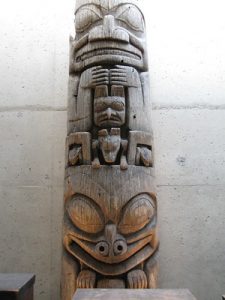Jessie Loyer
Question #6: What questions about Open Education are you grappling with?
My brain’s always on fire about this. What I’ve been thinking a lot about and I’ve mentioned it a bit in our time today but I really think about this idea of kinship. I’ve written about it. I think it’s important in the way that we teach as librarians. For me, it’s also thinking about our collections. The idea that in our collections, there’s kin-making there. That the people that take care of collections have a stewardship, are kin with the things that they take care of. But we’re not the only ones that have a relationship to those collections. Oftentimes, they need to go home when they need to or they need to be connected to their relatives. To me that’s a big part of what I’m always thinking about.
I just finished a book chapter that is talking about how so many of our collections emerge from a white man’s singular joy. Some guy said, “I like this, and I like this, and I like this.” Then that shapes our collection. We might add to it but it is the base of our collection. We can see that in our cataloging systems, we can see it in the way that Dewey for example is really obsessed with certain things. Even at the Library of Congress, the Thomas Jefferson influence on that is so apparent when you really look at it. These sorts of white man’s singular joy versus collections as relatives is so oppositional. I’m really excited about how those two things can play together. How we can send our relatives back home.
I’m also always excited about this idea of thinking about where an idea emerges from. For Open Access, for example we often talk about it in terms of stewardship. We want to do this for others, we want to make access easier for others. But when you ask me this question, one of the things that I think about is, because Open Access often is situated in a library and so much of library thinking is tied (whether we want it or not) to the idea of being a repository. Concepts around preservation are big in our minds. That’s what we learn in library school. That’s what shapes our work even as we want to encourage things that are not always in that realm. But with repositories and preservation shaping the way that Open Access looks, it makes me want to ask; What’s the end of the life cycle for some of these things? What about weeding things out or letting things die?

A good example is Haida totem poles. Haida totem poles were never meant to last forever. They were meant to eventually be laid down and go back to the earth, to rot back to the earth. But we now have many of them in museums where they’re cared for and they’re preserved for many different reasons. What excites me about this question of stepping outside of librarianship to think about Openness is this idea of letting things sleep again. When does something not become useful anymore but can be allowed to go and rest and sleep? Weeding is a big part of librarianship, but it’s not one that the public knows about, that we go through and we take things out. In Open Access, how do we let something go back to sleep? How do we let it sleep when it’s no longer useful right? I don’t even know how to begin to ask that question but it’s one that sort of was tickling my brain a bit. I’m thinking about how, when we make everything open, how do we then identify what’s still relevant to us.
